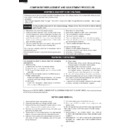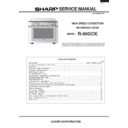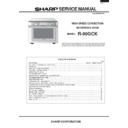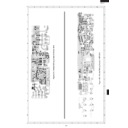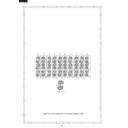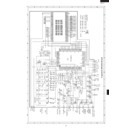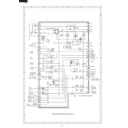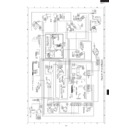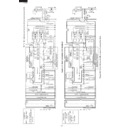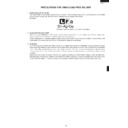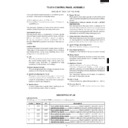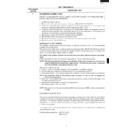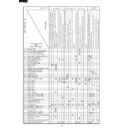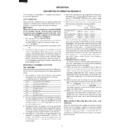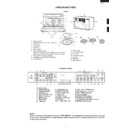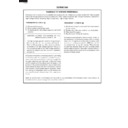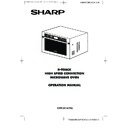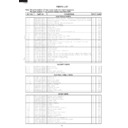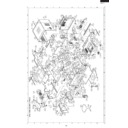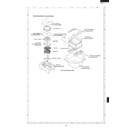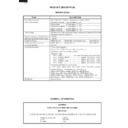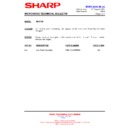Sharp R-90GCK (serv.man10) Service Manual ▷ View online
28
R-90GCK
angle A to the heater duct upper.
5. Remove the two (2) nuts holding the top heating
element to the heater duct upper.
6. Now, the top heating element is free.
1. Disconnect the oven from power supply.
2. Wait for 60 seconds to discharge the high voltage
2. Wait for 60 seconds to discharge the high voltage
capacitor.
3. Remove the turntable tray and the turntable support
from the oven cavity.
4. Lay the oven on its backside.
5. Remove the turntable motor cover by snipping off the
5. Remove the turntable motor cover by snipping off the
material in four corners.
6. Where the corners have been snipped off, bend corner
TURNTABLE MOTOR REMOVAL
areas flat. No sharp edges must be evident after
removal of the turntable motor.
removal of the turntable motor.
7. Disconnect the wire leads from the turntable motor.
8. Remove the one (1) screw holding the turntable motor
8. Remove the one (1) screw holding the turntable motor
to the oven cavity bottom plate.
9. Now, the turntable motor is free.
10.After replacement, use the one (1) screw to fit the
10.After replacement, use the one (1) screw to fit the
turntable motor cover.
1. CARRY OUT 3D CHECKS.
2. Remove the back plate from the oven, referring to
2. Remove the back plate from the oven, referring to
"BACK PLATE REMOVAL".
3. Remove the high voltage capacitor, referring to "HIGH
VOLTAGE CAPACITOR, HIGH VOLTAGE RECTIFIER
ASSEMBLY AND HIGH VOLTAGE FUSE REMOVAL".
ASSEMBLY AND HIGH VOLTAGE FUSE REMOVAL".
4. Now, the power supply cord should be disconnected
NOISE FILTER REMOVAL
from the noise filter.
5. Disconnect the main wire harness form the noise filter.
6. Remove the one (1) screw holding the noise filter to the
6. Remove the one (1) screw holding the noise filter to the
bottom plate.
7. Remove the noise filter from the bottom plate.
8. Remove the fuse from the noise filter.
9. Now, the noise filter is free.
8. Remove the fuse from the noise filter.
9. Now, the noise filter is free.
Removal
1. CARRY OUT 3D CHECKS.
2. Disconnect the wire leads from the switch.
3. Remove the one (1) screw holding the latch hook (right
1. CARRY OUT 3D CHECKS.
2. Disconnect the wire leads from the switch.
3. Remove the one (1) screw holding the latch hook (right
or left) to the oven cavity front plate, and release the
latch hook (right or left).
latch hook (right or left).
4. Keep pushing the stopper tub holding the switch to the
latch hook (right or left) and revolve the switch on the
pole.
pole.
5. Remove the switch from the latch hook (right or left).
6. Now, the switch is free.
Reinstallation
1. Reinstall the switch in its place. The door sensing
6. Now, the switch is free.
Reinstallation
1. Reinstall the switch in its place. The door sensing
switch is in the lower position of the latch hook right.
The 3rd. latch switch is in the upper position of the latch
hook right. The secondary interlock switch is in the
lower position of the latch hook left. And the monitor
switch is in the upper position of the latch hook left.
The 3rd. latch switch is in the upper position of the latch
hook right. The secondary interlock switch is in the
lower position of the latch hook left. And the monitor
switch is in the upper position of the latch hook left.
DOOR SENSING SWITCH, 3RD. LATCH SWITCH, SECONDARY INTERLOCK SWITCH AND
MONITOR SWITCH REPLACEMENT
2. Hold the latch hook (right or left) to the oven cavity front
plate with the one (1) screw.
3. Reconnect the wire leads to the switch.
4. Make sure that the monitor switch is operating properly
4. Make sure that the monitor switch is operating properly
and check continuity of the monitor circuit. Refer to
chapter “Test Procedure” and “Adjustment procedure.
chapter “Test Procedure” and “Adjustment procedure.
Figure C-2. Switches
If the door sensing switch, 3rd. latch switch, secondary
interlock switch and monitor switch do not operate prop-
erly due to a misadjustment, the following adjustment
should be made.
1. CARRY OUT 3D CHECKS.
2. Loosen each one (1) screw holding the latch hook right
interlock switch and monitor switch do not operate prop-
erly due to a misadjustment, the following adjustment
should be made.
1. CARRY OUT 3D CHECKS.
2. Loosen each one (1) screw holding the latch hook right
and the latch hook left to the oven cavity front plate.
3. With door closed, adjust the latch hook right and the latch
hook left by moving them back and forth, and up and
down. In and out play of the door allowed by the latch
hook right and the latch hook left should be less than 0.5
mm. The vertical position of the latch hook right and the
latch hook left should be adjusted so that the door
down. In and out play of the door allowed by the latch
hook right and the latch hook left should be less than 0.5
mm. The vertical position of the latch hook right and the
latch hook left should be adjusted so that the door
DOOR SENSING SWITCH, 3RD. LATCH SWITCH, SECONDARY INTERLOCK SWITCH AND
MONITOR SWITCH ADJUSTMENT
sensing switch and the secondary interlock switch are
activated with the door closed. The horizontal position of
the latch hook right and the latch hook left should be
adjusted so that the plungers of the 3rd. latch switch and
monitor switch are pressed with the door closed.
activated with the door closed. The horizontal position of
the latch hook right and the latch hook left should be
adjusted so that the plungers of the 3rd. latch switch and
monitor switch are pressed with the door closed.
4. Secure the screws firmly.
5. Check all of the switches operation. If any switch has
5. Check all of the switches operation. If any switch has
not activated with the door closed, loosen the screws
and adjust the position of the latch hook right and the
latch hook left.
and adjust the position of the latch hook right and the
latch hook left.
After adjustment, check the following.
1. In and out play of the door remains less than 0.5 mm
1. In and out play of the door remains less than 0.5 mm
when in the latched position. First check the position of
Monitor switch
Latch hook left
Secondary
interlock switch
(Monitored latch switch)
interlock switch
(Monitored latch switch)
Door sensing switch
Latch hook right
Pole
Pole
Pole
Stopper tab
Stopper
tab
tab
3rd. door
switch
switch
(Primary interlock relay
control switch)
control switch)
29
R-90GCK
the latch hook right, pushing and pulling right portion of
the door toward the oven face. Then check the position
of the latch hook left, pushing and pulling left portion of
the door toward the oven face. Both results (play in the
door) should be less than 0.5 mm.
the door toward the oven face. Then check the position
of the latch hook left, pushing and pulling left portion of
the door toward the oven face. Both results (play in the
door) should be less than 0.5 mm.
2. The door sensing switch, 3rd. latch switch and the
secondary interlock switch interrupt the circuit before
the door can be opened.
the door can be opened.
3. The monitor switch contacts close when the door is
opened.
4. Reinstall the outer case cabinet and check for
microwave leakage around the door with an approved
microwave survey meter. (Refer to Microwave
Measurement Procedure.)
microwave survey meter. (Refer to Microwave
Measurement Procedure.)
Figure C-3. Latch Switch Adjustment
Door assembly removal
1. CARRY OUT 3D CHECKS.
2. Close the door.
3. Remove the two (2) door springs from the door cam right,
2. Close the door.
3. Remove the two (2) door springs from the door cam right,
oven hinge right, door cam left and oven hinge left.
4. Release the door cams right and left from the right and
left door cam pins of the door.
5. Remove the door cams right and left from the oven
cavity front plate.
6. Open the door assembly at an angle of more than 90˚
with the oven cavity front plate.
7. To release the right and left door hinge pins of the door
assembly from the oven hinges right and left, slide the
door assembly leftward. When removing the door
assembly, hold the door assembly to prevent it from
falling.
door assembly leftward. When removing the door
assembly, hold the door assembly to prevent it from
falling.
8. Now, the door assembly is free.
NOTE: When the individual parts are replaced, refer to
NOTE: When the individual parts are replaced, refer to
“Door Disassembly”
Door assembly reinstallation
1. On reinstalling the door assembly, insert the oven hinges
right and left into the right and left door hinge pins.
2. Insert and hook the door cams right and left to the right
and left door cam pins.
3. Reinstall the two (2) door springs between the door
cams and the oven hinges right and left.
NOTE: After any service to the door;
(A) Make sure that the door sensing switch, 3rd. latch
(A) Make sure that the door sensing switch, 3rd. latch
switch, secondary interlock switch and the monitor
switch are operating properly. (Refer to chapter
“Test Procedure”.)
switch are operating properly. (Refer to chapter
“Test Procedure”.)
(B) An approved microwave survey meter should be
used to assure compliance with proper microwave
radiation emission limitation standards.
radiation emission limitation standards.
Door adjustment
When removing and/or loosening the oven hinges such as
in door replacement, the following adjustment criteria are
taken.
Door adjustment is performed with the door properly
installed and closed and while the oven hinges are loose.
1. Loosen the screws holding the oven hinge right and the
in door replacement, the following adjustment criteria are
taken.
Door adjustment is performed with the door properly
installed and closed and while the oven hinges are loose.
1. Loosen the screws holding the oven hinge right and the
oven hinge left to the bottom plate with screwdriver.
DOOR REPLACEMENT AND ADJUSTMENT
2. Adjust the door by moving it so that the door is parallel
with the oven cavity front plate lines (right and left side
lines) and the door latch heads pass through the latch
holes correctly.
lines) and the door latch heads pass through the latch
holes correctly.
3. Tighten the screws holding the oven hinge right and the
oven hinge left to the bottom plate.
After adjustment, make sure of the following:
1. The door latch heads smoothly catch the latch hooks
1. The door latch heads smoothly catch the latch hooks
through latch holes and the latch heads goes through
centre of latch holes.
centre of latch holes.
2. The door is positioned with its face pressed toward
oven cavity front plate.
3. Reinstall the outer case cabinet and check for
microwave leakage around the door with an approved
microwave survey meter. (Refer to Microwave
Measurement Procedure.)
microwave survey meter. (Refer to Microwave
Measurement Procedure.)
NOTE: The door on a microwave oven is designed to
act as an electronic seal preventing the leakage
of microwave energy from the oven cavity
during cook cycle. This function does not
require that the door be airtight, moisture
(condensation)-tight or light-tight. Therefore,
occasional appearance of moisture, light or
sensing of gentle warm air movement around
the oven door is not abnormal and do not of
themselves indicate a leakage of microwave
energy from the oven cavity. If such were the
case, your oven could not be equipped with a
vent, the very purpose of which is exhaust the
vapour-laden air from the oven cavity.
of microwave energy from the oven cavity
during cook cycle. This function does not
require that the door be airtight, moisture
(condensation)-tight or light-tight. Therefore,
occasional appearance of moisture, light or
sensing of gentle warm air movement around
the oven door is not abnormal and do not of
themselves indicate a leakage of microwave
energy from the oven cavity. If such were the
case, your oven could not be equipped with a
vent, the very purpose of which is exhaust the
vapour-laden air from the oven cavity.
Figure C-4(a). Door Replacement
Door cam left
Door
assembly
assembly
Door
spring
spring
Door spring
Oven hinge
left
left
Oven hinge
right
right
Door cam right
Monitor switch
Latch hook left
Latch
head
head
3rd. latch
switch
switch
Secondary
interlock switch
(Monitored latch switch)
interlock switch
(Monitored latch switch)
Door
sensing switch
(Primary interlock
relay control switch)
sensing switch
(Primary interlock
relay control switch)
Latch hook right
Latch
head
head
30
R-90GCK
Choke
Cover
Cover
Door
Frame
Frame
Door Panel
Assembly
Assembly
Putty Knife
Door cam left
Door
assembly
assembly
Oven hinge
left
left
Oven hinge
right
right
Door cam right
Left door
cam pin
cam pin
Right door
cam pin
cam pin
Left door
hinge pin
hinge pin
Right door
hinge pin
hinge pin
Figure C-4(b). Door Replacement
1. CARRY OUT 3D CHECKS.
2. Remove the door assembly, referring to “Door
2. Remove the door assembly, referring to “Door
Replacement”.
3. Place the door assembly on a soft cloth with latch
heads facing up.
NOTE: As the engaging parts of the choke cover and
the door panel assembly are provided at 16
places, do not force any particular part.
places, do not force any particular part.
4. Replacement of the door components are as follows:
CHOKE COVER
5. Insert a putty knife (thickness of about 0.5 mm) into the
gap between the choke cover and the door panel
assembly as shown in Figure C-5.
assembly as shown in Figure C-5.
6. Lift up the choke cover.
7. Now, the choke cover is free from the door panel
7. Now, the choke cover is free from the door panel
assembly.
NOTE: When carrying out any repair to the door, do
not bend or wrap the slit choke (tabs on the
door panel assembly) to prevent microwave
leakage.
door panel assembly) to prevent microwave
leakage.
DOOR HANDLE ASSEMBLY
8. Remove the two (2) screws holding the door handle
assembly to the door panel assembly through the door
frame.
frame.
9. Now, the door handle is free.
DOOR PANEL ASSEMBLY, LATCH HEAD R AND
LATCH HEAD L
LATCH HEAD L
10.Remove the fourteen (14) screws holding the door
panel assembly to the door frame.
11.Remove the door panel assembly from the door frame.
12.Remove the one (1) screw holding the latch head R to
12.Remove the one (1) screw holding the latch head R to
the door panel assembly.
13.Remove the latch spring R from the latch head R and
the handle lever.
14.Now, the latch head R is free.
15.Remove the one (1) screw holding the latch head L to
15.Remove the one (1) screw holding the latch head L to
the door panel assembly.
DOOR DISASSEMBLY
16.Remove the latch spring L from the latch head L and the
handle lever.
17.Now, the latch head L is free.
18.Release the two (2) handle springs from the two (2)
18.Release the two (2) handle springs from the two (2)
handle levers.
19.Pull out the two (2) handle pins from the two (2) handle
levers.
20.Remove the two (2) handle levers from the door panel.
21.Now, the door panel is free.
21.Now, the door panel is free.
MIDDLE DOOR GLASS
22.Remove the two (2) screws holding the glass mounting
angle B to the door frame.
23.Remove the middle door glass from the door frame.
24.Now, the middle door glass is free.
24.Now, the middle door glass is free.
FRONT DOOR GLASS
25.Remove each two (2) screws holding the two glass
mounting angles A to the door frame.
26.Remove the two (2) glass mounting angles A from the
door frame.
27.To release the two (2) tabs holding the lower end of the
front door glass, slide the front door glass upward.
28.Release the three (3) tabs holding the upper end of the
front door glass and remove the front door glass from
the door frame.
the door frame.
29.Now, the front door glass is free.
Figure C-5. Door Disassembly
CONTROL PANEL ASSEMBLY AND CPU UNIT REMOVAL
Control panel assembly
1. CARRY OUT 3D CHECKS.
2. Disconnect the 20-pin harness from the connectors
2. Disconnect the 20-pin harness from the connectors
CN-G and CN-H on the power unit.
3. Remove the four (4) screws holding the control panel
assembly to the oven cavity front plate.
4. Slide the control panel assembly leftward to release
the eight (8) tabs of the control panel assembly from the
oven cavity front plate.
oven cavity front plate.
5. Now, the control panel assembly is free.
31
R-90GCK
Tabs
Screw
Screw
Panel angl
Panel sub assembly
Bottom side of
panel sub assembly
panel sub assembly
CPU unit
6. Remove the two (2) screws holding the panel angle to
the panel sub assembly.
7. Release the panel angle from the two (2) tabs of the
panel sub assembly first.
8. Pull out the panel angle from the panel sub assembly
and remove it.
9. Remove the twenty-two (22) screws holding the CUP
unit to the panel sub assembly.
10.Now, the CPU unit is free.
NOTE: After the panel angle is removed from the
NOTE: After the panel angle is removed from the
panel sub assembly, it is can be found that the
bottom side of the panel sub assembly is
bottom side of the panel sub assembly is
melted and transformed by heat. But it is not
abnormal and no problem to use the oven.
abnormal and no problem to use the oven.
Figure C-6. Panel Angle Removal
MICROWAVE MEASUREMENT
After any repair, the microwave oven must be checked for
microwave leakage to ensure continued safe operation.
BS EN 60335-2-25 specifies that the maximum permitted
leakage with a load of 275 ml is 50 W/m
microwave leakage to ensure continued safe operation.
BS EN 60335-2-25 specifies that the maximum permitted
leakage with a load of 275 ml is 50 W/m
2
(equivalent to 5
mW/cm
2
)
at a distance of 5 cm from the oven.
PREPARATION
The following items are required to carry out this test:-
1. A low form of 600 ml beaker made from an electrically
1. A low form of 600 ml beaker made from an electrically
non-conductive material, such as glass or plastic, with
an inside diameter of approximately 8.5 cm. This must
contain 275
an inside diameter of approximately 8.5 cm. This must
contain 275
±
15 ml of water, at an initial temperature
of 20
±
2˚C.
2. A leakage detector which has been calibrated within
the preceding 12 months to a stand whose accuracy
can be traced to National Physical Laboratory
Standards.
can be traced to National Physical Laboratory
Standards.
Recommended instruments are:
Apollo "XI"
Celtec "A100"
Celtec "A100"
Before commencing the test, check that the leakage
detector is functioning and adjusted according to the
manufacturer's instructions, and any spacers are fitted to
ensure that measurement is taken 5cm from the surface of
the oven.
detector is functioning and adjusted according to the
manufacturer's instructions, and any spacers are fitted to
ensure that measurement is taken 5cm from the surface of
the oven.
PROCEDURE
1. Place the beaker containing the water load in the oven
cavity at the centre of the turntable. The placing of this
standard load in the oven is important, not only to
protect the oven, but also to ensure that any leakage it
is not disguised by too large a load absorbing energy.
standard load in the oven is important, not only to
protect the oven, but also to ensure that any leakage it
is not disguised by too large a load absorbing energy.
2. Close the oven door, and with the power level set to
FULL, turn the oven ON with the timer set for a few
minutes operation. Should the water begin to boil
before the test has been completed, it should be
replaced.
minutes operation. Should the water begin to boil
before the test has been completed, it should be
replaced.
3. As shown in the diagram below, move the probe slowly
(not faster than 2.5 cm/sec.);-
a) around the edge of the door following the gap
b) across the face of the door
c) across any vents in the oven's sides, rear or top
b) across the face of the door
c) across any vents in the oven's sides, rear or top
Whilst the maximum leakage permitted in BS EN 60335-2-25 is 50 W/m
2
(equivalent to 5 mW/cm
2
), it is not normal
to detect any significant leakage, and therefore any detected leakage should be investigated.
Dotted line indicates the path taken by the leakage detector.
Display

